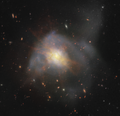پرونده:Arp 220 - JWST, HST.png
ظاهر

اندازهٔ این پیشنمایش: ۶۲۴ × ۶۰۰ پیکسل. کیفیتهای دیگر: ۲۵۰ × ۲۴۰ پیکسل | ۴۹۹ × ۴۸۰ پیکسل | ۷۹۹ × ۷۶۸ پیکسل | ۱٬۰۶۵ × ۱٬۰۲۴ پیکسل | ۲٬۱۳۰ × ۲٬۰۴۸ پیکسل | ۴٬۱۹۵ × ۴٬۰۳۳ پیکسل.
پروندهٔ اصلی (۴٬۱۹۵ × ۴٬۰۳۳ پیکسل، اندازهٔ پرونده: ۲۲٫۳۵ مگابایت، نوع MIME پرونده: image/png)
تاریخچهٔ پرونده
روی تاریخ/زمانها کلیک کنید تا نسخهٔ مربوط به آن هنگام را ببینید.
| تاریخ/زمان | بندانگشتی | ابعاد | کاربر | توضیح | |
|---|---|---|---|---|---|
| کنونی | ۹ مارس ۲۰۲۳، ساعت ۲۲:۰۸ |  | ۴٬۱۹۵ در ۴٬۰۳۳ (۲۲٫۳۵ مگابایت) | Fabian RRRR | =={{int:filedesc}}== {{Information |Description=A combination of JWST and HST data showing a new view of ultraluminous infrared galaxy [https://en.wikipedia.org/wiki/Arp_220 Arp 220]. Here, I've tried to cut down on the redness because if I were to simply take all the data and throw it together, much of the galaxy would be lost in a red glare. Instead, the central details are actually visible. This is important because the imagery reveals what I presume to be the cores of the two galaxies tha... |
کاربرد پرونده
صفحهٔ زیر از این تصویر استفاده میکند:
کاربرد سراسری پرونده
ویکیهای دیگر زیر از این پرونده استفاده میکنند:
